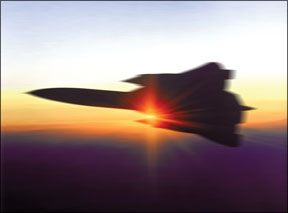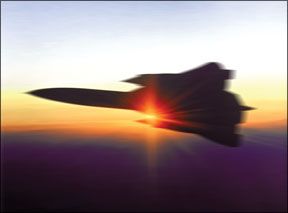One of the reasons people become pilots is we like the idea of going fast. As children with a Radio Flyer wagon at the top of a hill, we learn very early going fast can be fun but also has some associated dangers, usually summarized as “going too fast.” Even though were older, presumably wiser and flying what might be the latest airframe with all the whiz-bang gadgetry in it we can afford, theres 288 still such a thing as going too fast. Once the aircraft leaves the surface, using visual cues to determine the speed at which we are moving through the air isnt possible. Even while on the runway, if there is any surface wind, pilots know airspeed can be substantially different than the speed we appear to be moving. Aircraft are equipped with an instrument used to determine airspeed, but there are many problems associated with using the airspeed indicator to help us determine the appropriate pitch or power for a given flight situation. Viewing the airspeed indicator is often only the starting point in determining the actual or appropriate speed for a specific configuration, maneuver or situation. How do we know what is “going too fast” for an airplane? Airspeed Indicator 101 The airspeed indicators face is color-coded to help us remember some of the airspeeds designated as appropriate for different configurations and maneuvers. Other important speeds are listed only in the aircrafts documentation. But since this article is about “going too fast,” well explore the correct interpretation of VA (maneuvering) and VNE (never exceed) airspeeds. Why are we concerned about these speeds? Because exceeding either of them-especially at the wrong time-can result in a catastrophic failure of an essential aircraft structure. A good point from which to begin improving our understanding of the airspeed indicator is to realize that the airspeed indicator does not actually measure airspeed. It measures dynamic pressure resulting from packing air molecules into the pitot tube. Aircraft designers and engineers label this dynamic pressure as “q.” The airspeed indicators face is calibrated so “q” measurements will correspond to the distance the aircraft travels over the ground each hour in still air, at sea level density altitude and in standard atmospheric conditions. If the altitude, temperature or barometric pressure vary from standard-as they almost always do-then “q” will no longer represent the distance traveled through the air during one hour of flight. Various factors-installation errors-affect the rate at which air molecules are packed into the pitot tube. Among them are location of the pitot tube, the relative winds angle and wing-flap position. The indicated speed (IAS) corrected for these installation errors is the calibrated airspeed (CAS). Many important speeds for a specific aircraft such as liftoff speed, VS0 (stall or minimum steady flight speed in the landing configuration, depicted as the bottom of the green arc), final approach speed ( 1.3 x VS0) and VNO (normal operating speed in smooth air, depicted as the top of the green arc) are a function of “q,” so these speeds can be read directly from the airspeed indicator dial. Whats Missing? Of course, other important speeds such as VA and best glide are not on the airspeed indicator. Best glide speed, of course, is the speed resulting in the greatest glide distance. Meanwhile, VA is the design maneuvering speed, or maximum speed at which full, rapid control movement or rough air would not risk structural damage to the aircraft. The values of VNE and best glide listed in the POH change as actual aircraft weight changes. Maneuvering speed (VA) is normally well below the top of the green arc or VNO speed. When the airplane is flown below VA speed, its wings will stall before excessive loads can be generated that would cause structural damage to the aircraft. Flying faster than VA when experiencing or anticipating very rough air or applying full control deflection risks aircraft damage, or even loss of the aircraft. The speed is not shown on the face of the airspeed indicator because VA decreases as the aircrafts gross weight decreases. An easy way to remember this is to imagine a heavy wood log and a same size cork log floating down a stream rapids. Obviously, the cork log will get tossed about more violently. These speeds may be listed in the POH only for the maximum gross weight of the aircraft. Since both of these speeds are important for safe aircraft operation, the pilot should determine the VA and best glide speed values for lighter aircraft weights before takeoff. As an example, the table above right presents VNE, VNO, VA and best glide speeds for a representative Mooney 231 at various weights. Not Indicated One might presume all speed values depicted on the airspeed indicator are indicated airspeeds. This is true to an extent: All of the colored arc ranges on the airspeed indicator are based on indicated airspeeds. And, as we know, the VNE red-line or never-exceed speed of the aircraft is depicted by a red line on the aircraft airspeed indicator at the top of the yellow arc. However, it is very important to understand VNE is not an indicated airspeed. Instead, VNE is a true airspeed. Of course, true airspeed and indicated airspeed are going to be the same value only at sea level density altitude with standard atmospheric conditions. At much higher density altitudes, flying at an indicated airspeed, even in the green arc below VNO, can result in a true airspeed substantially exceeding the VNE red-line. Thats bad. In a Mooney 231, the top of the green arc (VNO) is 174 knots. At any altitude above density altitude of 8000 feet, a calibrated airspeed of 174 knots would yield a true airspeed greater than the 196-knot VNE. Meanwhile, initiating a rapid descent from 12,000 feet or greater in a Cessna 172P could easily exceed 132 KCAS, which would exceed the aircrafts true airspeed VNE of 158 knots. The tables in the sidebar on the opposite page list the VNE of the Mooney 231 and Cessna 172P for various altitudes, expressed in calibrated airspeed. Flutter Most rated pilots understand exceeding the redline airspeed might result in some undesirable damage to the aircraft, but they may be unaware about what specifically could happen. When I attended flight school many years ago, I viewed a film showing a light aircraft exceeding the redline airspeed with a camera mounted to view the horizontal stabilizer. When the speed exceeded the redline airspeed by a few knots, the horizontal stabilizer began violently flapping up and down several inches. If this vibration is allowed to continue for even a few seconds, the aircraft could be totally lost. This kind of behavior by the horizontal stabilizer in the film is called “flutter.” Any aircraft structure-wings, horizontal and vertical stabilizers, elevators, ailerons, rudders, propellers and other components-can be destroyed by flutter. Once flutter begins, it can destroy an aircraft in just a few seconds. Moreover, it may not be possible for the pilot to take action to stop flutter once it begins. Flutter, also known as aeroelastic flutter, has been studied by engineers and scientists for many years, and a wide variety of technical discussions and descriptions exist. The FAA describes flutter as, “The unstable, self-excited oscillation of an airfoil and its associated structure, caused by a combination of aerodynamic, inertia, and elastic effects in such a manner as to extract energy from the airstream.” Simple examples of flutter are the rapid vibrations at the downwind end of a flag in a strong wind or the vibration of a musical instrument reed such as used with a saxophone. In both examples, a rapid vibration is started and maintained by a high velocity stream of air passing over a flexible objects surface. And flutter can affect anything over which air passes, not just airframe components. Famously, the Tacoma (Wash.) Narrows Bridge was destroyed in 1940 by flutter resulting from a 40-mile-per-hour wind. This structure and many airplanes were destroyed before engineers fully understood flutter and how to design objects to minimize the possibility of flutter damage to objects. Preventing Flutter Aircraft designers determine the maximum speed at which the aircraft will be flown in level flight and establish a VNE some percentage above that speed. The percentage above maximum level flight speed will depend to some extent on the type of operations for which the aircraft is being designed. The prototype is tested at altitude for any occurrence of flutter at all speeds up to about 110 percent of the VNE speed, with test pilots wearing parachutes. Thats because if the test aircraft experiences flutter, it can very quickly result in violent destruction of critical flight structures. Flutter begins when the velocity of the air over a stiff but flexible object exceeds a particular speed. As an aircraft climbs in altitude, there is less pressure and fewer molecules of air in a given volume. In order to maintain the same “q,” or dynamic pressure in the pitot tube, the aircrafts velocity through the surrounding air molecules has to be increased, which is why the true airspeed increases with altitude if we keep the indicated airspeed constant. Determining the aircrafts VNE speed limit in terms of the value the airspeed indicator points to requires holding constant the aircrafts VNE true airspeed and the corresponding calibrated airspeed is noted. Because of the widespread use of excellent flight planners that automatically calculate groundspeed using current winds and temperature forecasts, very few pilots still use an E6B or electronic calculator to calculate true airspeeds prior to flight. GPS and DME radios supply almost instantaneous ground speed values during flight, eliminating any need to calculate true airspeed for navigational purposes during flight. However, its good practice to construct a table with calibrated airspeed values that correspond to the true airspeed VNE at each 1000-foot density altitude increment your aircraft is likely to fly and keep the table with your checklist. The table can easily be constructed in about five minutes using an E6B. Simply use the airspeed correction windows. For each 1000-foot density altitude, locate the aircraft VNE speed value on the outside ring. Opposite that value, read the calibrated airspeed value displayed on the inside ring. Two tables, representing the results of these calculations for the Mooney 231 and the Cessna 172P, are reproduced on page 7. The higher the airplanes normal operating altitude, the greater is the risk of exceeding VNE. And it doesnt require a powered aircraft to risk an airframe failure. Sailplanes also have a published VNE, and-using the mountain-wave effects-often are taken to extremely high density altitudes. At high altitudes, the sailplanes specified VNE can result in an indicated airspeed limitation well below the top of the normal operating range green arc. For example, the Grob G-103 has a VNE of 135 knots and a green arc range of 42 to 92 knots. At a density altitude of 30,000 feet, the VNE would be equivalent to 83 knots indicated airspeed, which is almost 10 knots below the top of the green arc VNO. When Speed can Destroy In theory, a certified and properly maintained aircraft should not exhibit flutter if its not flown faster than its VNE true airspeed. For normal operations of personal airplanes, there are two scenarios where exceeding the true airspeed VNE can occur easily: a rapid descent from a high altitude by a normally aspirated aircraft or a turbocharged aircraft operating at high altitude. An educated pilot will fully understand that the indicated airspeed at which the aircraft can be flown safely, when flying at altitudes above sea level density altitude, is below the redline on the airspeed indicator and substantially below it at high altitudes.




